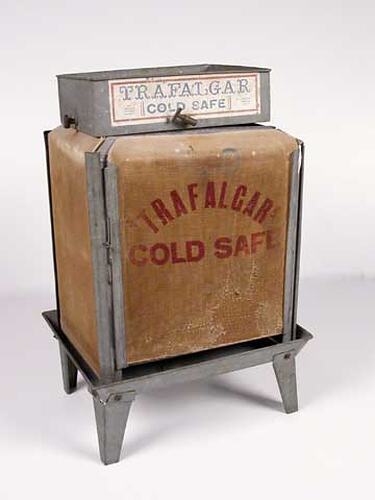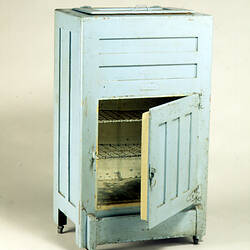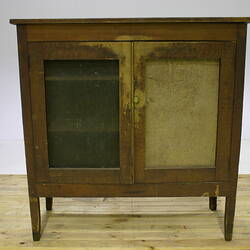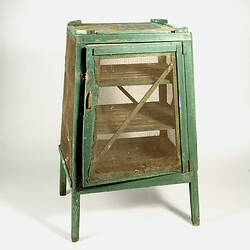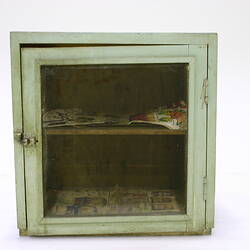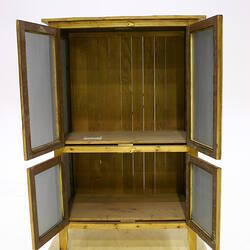Coolgardie Safe, Cooling Chest
Invention of the Coolgardie Safe is credited to Arthur Patrick McCormick, a contractor in Coolgardie, and later Mayor of Narrogin. Coolgardie is in the Eastern Goldfields region of Western Australia. Gold was first discovered there in 1892, the townsite became a municipality in 1894, and by 1898 its population of 15,000 made it the third largest town in WA after Perth and Fremantle. In the last decade of the 19th century Coolgardie was the capital of the West Australian goldfields. Being 180 kilometres from the nearest civilisation, food supplies were initially scarce and expensive. As fresh food was a valuable commodity, there was incentive to preserve it and keep it out of reach of scavengers. It was in an effort to do this that McCormick came up with his design for the Coolgardie Safe.
McCormick noticed that a wet bag placed over a bottle cooled its contents. He further noted that if this bottle was placed in a draught, the bag would dry out more quickly, but the bottle would get colder. What McCormick had discovered was the principle of evaporation: 'to change any liquid into a gaseous state requires energy. This energy is taken in the form of heat from its surroundings.' (Ingpen 1982, p. 18) Employing this principle, McCormick made a box for his provisions which he covered with a wet Hessian bag. He then placed a tray on top, into which he poured water twice daily. He hung strips of flannel from the tray so that water would drip down onto the Hessian bag, keeping it damp.
The success of McCormick's invention would not have worked without a steady supply of water. Fresh water was scarce in the eastern goldfields at this time but the demand for water from a steadily growing population encouraged innovation. The solution was to condense salt water. Heating salt water in tanks produced steam that was condensed in tall cylinders, cooled and then collected in catchment trays. By 1898 there were six companies supplying condensed water to the goldfields, the largest company producing 100,000 gallons of water a day. (1992, p.11)
McCormick's safe was handmade using materials to hand. Many other prospectors in the Coolgardie region copied the design. In the early 20th century, Coolgardie Safes were manufactured commercially across Australia. These safes incorporated shelving and a door, had metal or wooden frames and Hessian bodies. The feet of the safe were usually placed in a tray of water to keep ants away.
Meat Safe, Food Safe
Meat Safes/Food Safes are containers used principally to keep food safe (from flies and other pests), clean and cool. They have been used to store perishable foodstuffs for centuries, and are still made and used today. Whether homemade or manufactured, their construction is simple; it consists of a frame made of metal or wood, with wire mesh panels. Meat/ Food Safes vary in size from portable cages that can be hung, to fixed items of kitchen or pantry furniture. They are usually placed in a well ventilated area to allow for air flow, thus ensuring the produce is kept cool.
References:
(1992). Worth its weight: a celebration of Coolgardie's centenary, 1892-1992. LISWA, Perth
Bonney, W.H. (1895). The History of Coolgardie. Hann, Enright & Co., Perth
Coleman, Ruth. Memories of Childhood. Available online at suthshirehistsoc.netfirms.com/memories%20of%20childhood.htm (3rd January 2005)
Ingpen, Robert (1982). Australian Inventions and Innovations. Rigby, Australia
Ierley, Merritt (1999). The Comforts of Home. The American house and the evolution of modern convenience. Clarkson Potter Publishers, New York
The-Real-Kenneth-Williams-Story. A Coin Operated Gas Meter, More Music and a Witch. Available online at pages.zdnet.com/hookares/the-real-kenneth-williams-story/id2.html
More Information
-
Keywords
-
Authors
-
Article types
